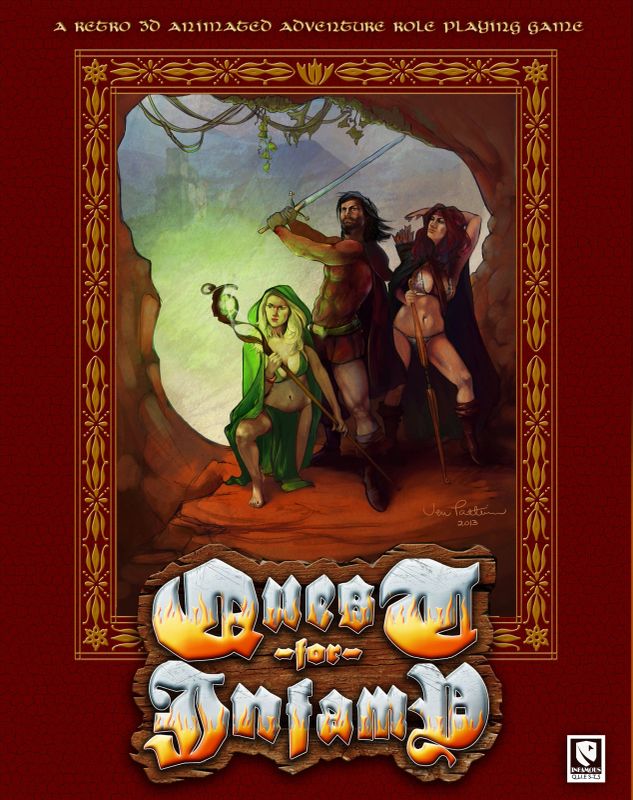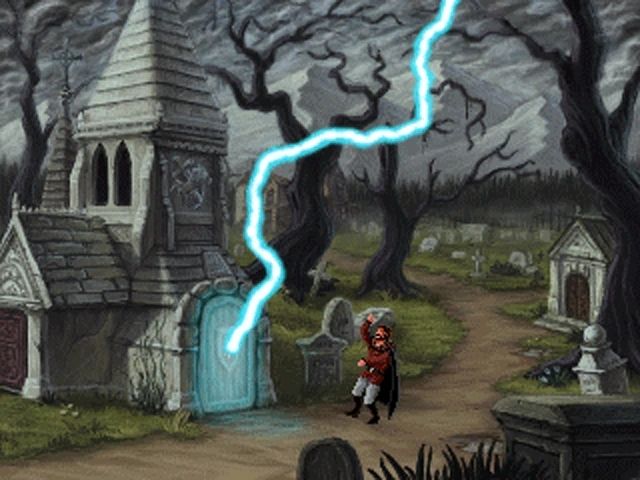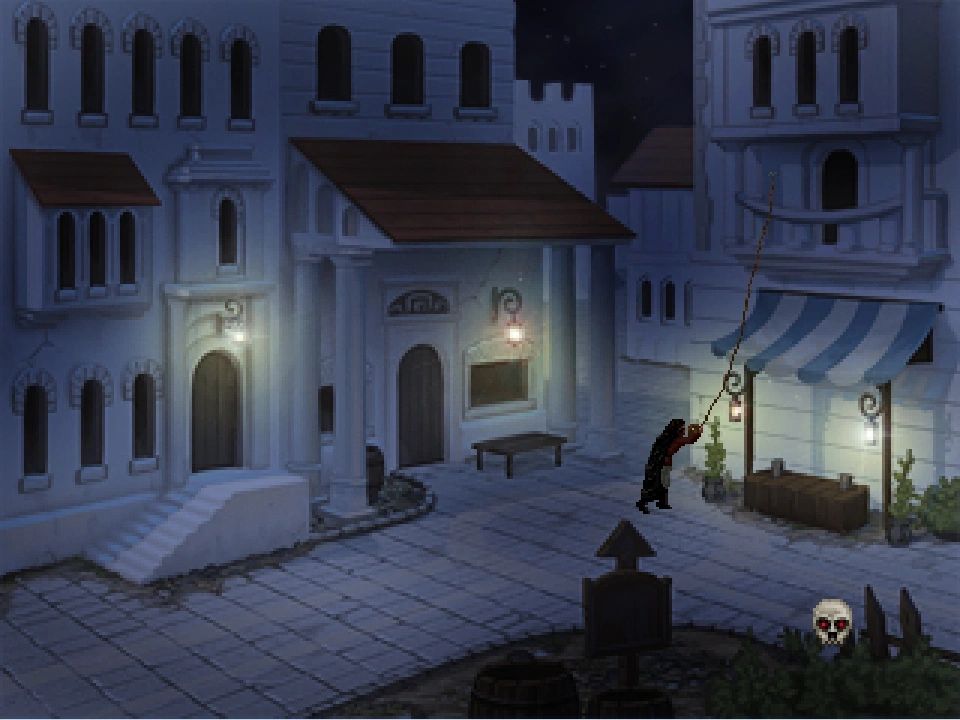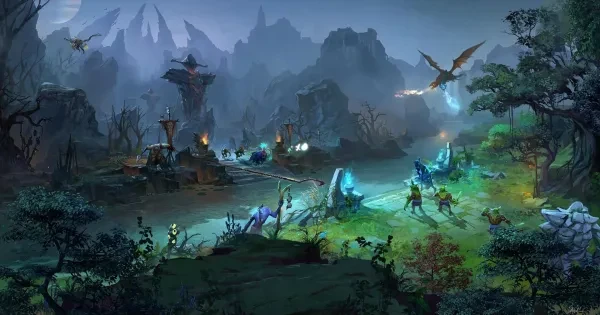Quest for Infamy Review – The Jump to Console is Always Tricky – WGB, Home of AWESOME Reviews
[ad_1]

We live in an age of remakes, remasters and re-releases. It allows whole new audiences to explore games from a different generation or can breathe new life into a cult classic. But it also means we often end up seeing some very odd re-releases and ports as companies attempt to squeeze out a little more money from their games, and Quest for Infamy certainly feels like one of those odder choices. First released on the PC back in 2016, Quest for Infamy is a successor of sorts to the old Quest for Glory titles, a blend of point and click puzzling and RPG mechanics. Now, Quest for Infamy brings its love of those largely forgotten games to the Nintendo Switch, Playstation and Xbox.
Having had a dalliance with another man’s wife, our “hero” Mr. Roehm has to leave town in a hurry. He finds himself in the small town of Volksville, near the mighty city of Tyr. The bridge is currently out, awaiting repair by th royale engineers, and thus Roehm has to stopover in the beautiful little valley for a few days. No problem, right? Well, it wouldn’t be a game if it wasn’t. Before long Roehm finds himself caught up in a cult, nefarious plots and the search for a legendary jewel that contains immense power. He’ll fight monsters, rappel down cliffs, buy tobacco, flirt with scantily-clad ladies and casually insult people in an entertaining, albeit forgettable, tale.
Available On: PC, Playstation, Xbox, Switch
Reviewed On: Switch
Developed By: Infamous Quests
Published By: Ratalaika GamesReview code provided by the publisher.
Roehm himself is something of an antihero. He’s a rogue with a quick, sarcastic wit that can land him in serious trouble, and one or two moments in the game let you define just how far he’ll go. The game’s description refers to him as a villain, but I wouldn’t agree; although you have some options to rob a couple of houses and perform a few nefarious acts he’s about as villainous as a carved Halloween pumpkin. Two things act against Roehm; firstly, he doesn’t have the charisma or badassery required to pull off the anti-hero/rogue vibe. He’s like that dude down at the pub who you don’t mind having a drink with because he’s a bit of a laugh, but that’s as far as friendship will ever go because you also know he’s about as reliable as a plumber’s estimate. The second thing is that Roehm has absolutely no agency in his story, no drive and no passion for anything going on. The unwilling character dragged into a situation they have no personal stake in is a solid basis for a story, but eventually, the protagonist has to have something to latch onto and Roehm never finds that. He bumbles from thing to thing with all the mumbled interest of a teenager being dragged around a shop by their mum. At one point he’s blackmailed and barely seems to care. Once the third act kicks off Roehm finally seems to get some motivation but it’s far too late because ten minutes later the game is over.
But while I don’t view Roehm as a very effective character, he’s certainly an amiable enough one and his snarky comments and comebacks land more than they miss. The same can be said for most of the story and humour; there are plenty of fun references and the jokes did make me crack a few smiles. I can’t say I was ever invested in the story, but it was pleasant enough. Far more interesting is the world of Quest for Infamy. There’s a substantial amount of area to cover, and while much of it is empty, it’s all beautifully rendered in the game’s lovely pixellated art style. There are heaps of NPCs too, and even the ones that serve absolutely no practical purpose are given plenty of dialogue. Overall, I was left with the impression of a much bigger and more detailed world sitting outside of my purview, which I loved. It makes me interested in the idea of a sequel that can more fully explore the world, but more on that later.
Given the small development team, I don’t think it’s surprising to say that the quality of voice acting ranges from decent to fairly bad. I have absolutely no problem with that. Good voice actors aren’t easy to find and are a massive strain to any small indie team’s already limited budget. I do, however, have an issue with a few performances that sound as though they were recorded in tiled bathrooms. These should have been re-recorded or cut out of the game. Thankfully, there are only a few such moments.

Primarily, Quest for Infamy plays out like a classic point and click adventure game. You’ll chat with characters, pick up items and solve puzzles in a bid to move the story along. There’s very little in the way of hand-holding; from the opening moments, you’re dumped into Volksville with absolutely no specific goals, although there is a decent quick-start walkthrough included in the game. It’s a theme throughout the entire adventure, with quite a few moments that left me scratching my head and wondering where I was meant to be going. It’s a pleasant change of pace, and there’s even a hint system of sorts in the form of a fortune-teller.
The good news is that when you find the direction you need to be heading, there are very few insane leaps of logic to contend with. The adventure genre is renowned for its baffling puzzles, but aside from one instance involving lighting a bush on fire using rubbing alcohol, everything feels mostly logical. By scouring your inventory, paying attention to what people are saying or even visiting the library you can piece things together. Although I have a soft spot in my heart for the absurd conundrums found in the classics, most people who play them want to punch the developers. These are satisfying to work through and solidly designed. Best of all, a lot of problems have multiple solutions.
Many of those solutions are due to a decision you make early in Quest for Infamy; will you walk the path of the Brigand, stroll the planes of Magic or sneak down the alleyways of the Rogue> Whichever one you choose the flow of the game will be altered with certain objectives and puzzles being tackled differently, and unique quest lines popping up. I went with the Rogue, giving me the option to break into a handful of houses in order to acquire Blys (the game’s money) that I could use to purchase essential items. Not that I actually needed to: I completed one quest for the local boss of the thieves guild, never broke into houses that I wasn’t required to for the story and still managed to buy or find everything I could possibly need. Still, it’s a cool idea and gives Quest for Infamy some solid replay value.

I’m far less convinced about the “RPG” elements that pop up and then vanish like my motivation. If you sneak around then your “stealth” will level up. What does that mean? I have no idea. The game claims a higher stealth rating decreases my chances of being detected and yet that never seemed to be an issue anyway, despite never practising sneaking. So either I got lucky, or it doesn’t matter. Stuff like climbing makes a bit more sense because there are certain things you can’t climb until you git gud scrub, but again that only comes up a few times and you can simply spam the interaction button until your climbing levels up sufficiently to pass over the obstacle.
Those RPG mechanics pop up in the awful combat that you’ll occasionally be forced into, either because of a story-based objective or because of a random encounter as you amble around the surprisingly big world. When you face off against an opponent it’s a blend of real-time and turn-based, with the idea being that you can perform an action every 3 seconds. Don’t do anything and the enemy will just go again. The most powerful option you have is your chosen class’s special move, but a recharge time stops it from being abused. You can also opt to block or chug a health potion. And then you have four offensive moves such as a stab or a slash and…that’s kind of it. An invisible roll of the dice determines success or failure, and if there’s any difference in any of the attacks I can’t find them. Seriously. None of them appears to be more effective against specific enemies, nor does matching them to a foe’s attack seem to help. The only thing to consider is that using an attack increases your stats, making you more likely to land a hit when using it. Or to put it simply; use the same move all the time. Combat is simply atrocious and a waste of time and effort. You either spam a single attack while waiting for your special ability to charge, or you spam block while waiting for the ability to charge. That’s it.
Quest for Infamy sticks closely to its inspirations, including the control scheme which was quite clearly built with PC in mind and hasn’t been translated very well to console. A modern adventure game mechanic would have greatly helped here. I’m talking about a contextual cursor that automatically changes based on what you hover over. For example, in other point and click games if you move the cursor over a door it’ll change to the use function automatically because nine times out of ten you just want to open the door. Likewise hovering over an object would usually bring up the pick up or examine icons, the two most likely things you need to do. It makes for a much smoother, quicker experience on consoles. But Quest for Infamy doesn’t do that, instead, you can cycle through the available movement and interaction options with the shoulder buttons, or you can select them from a bar on the top of the screen. It’s a far slower process, especially when the inputs sometimes fail to register and the cursor speed is sluggish. I honestly dread to think how much of my time with the game was spent flicking through walk, sneak, run, use, look and so on.

Another control issue is that you can’t go through menus and dialogue choices using the D-Pad and face buttons. Nope, you have to use the cursor for everything, which is a real pain in the butt cheeks on console.
Before I close out this review I do need to tackle how I approach games. You see, Quest for Infamy was a small independent game, worked on by a tiny team for years, a team who adored the old Sierra titles. And based on some of the Steam updates I’ve read it seems like it’s down to a single developer who has some health issues. There’s even a sequel in the works titled Road to Roehm, and you can support the creation of it over on Patreon.
The reason I tell you all this is because I don’t want to create the idea that any review I write is a personal attack against the people who made the game. When I tackle a game I try to keep all the development stuff, the people and so on out of the picture whenever I can because the consumer ultimately should be focused on themselves – is this game worth your time and your money?
Quest for Infamy didn’t hit right for me, yet plenty of people on Steam have thoroughly enjoyed it and its obvious passion for the games of yore. On PC it’s probably a stronger game, too, where the humble mouse lets you quickly move about and pick options. Its jump over to consoles could have done with more work on the control scheme, as that is probably my biggest criticism. Constantly battling the controls, which never became muscle memory over the 4-6 hours the game takes to complete, really does detract greatly from the experience.
Outside of those issues, Quest for Infamy never commits to its ideas. Roehm isn’t a villain or a bad guy, or at least not to enough of an extent to make him interesting. Instead, he’s polite to most people and only occasionally unleashes a snarky comment. The rest of the time he’s carried along by the plot like a piece of debris in the ocean and only becomes truly engaged in the final 20-minutes.
The point and click puzzling is solid, but the combat and the RPG mechanics just do not work. The former is horrible, to the point that I hated every fight I was involved in and had to force myself through them. And the latter isn’t developed enough, much like the class system or even the economy. The result is a scruffy, messy game that maybe should have focused more on one or two core features. Had Quest for Infamy been just a point and click puzzle game I think it would have been far stronger. But then again, maybe it’s just not for me. I grew up on Monkey Island, Discworld and Day of the Tentacle, not Quest for Glory, and that might just make all the difference.
Categories: Reviews, Videogame Reviews
[ad_2]
Source link








